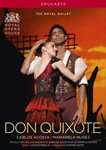|
Back
05/21/2014
Ludwig Minkus: Don Quixote (arranged and orchestrated by Martin Yates)
Marianela Nuñez (Kitri), Carlos Acosta (Basilo), Christopher Saunders (Don Quixote), Philip Mosley (Sancho Panza), Ryoichi Hirano (Espada), Laura Morera (Mercedes), Bennet Gartside (Gamache), Gary Avis (Lorenzo), Mellissa Hamilton (Queen of the Dryads), Elizabeth Harrod (Amour), Christina Arestis (Dulcinea), Yuhui Choe, Beatriz Stix-Brunel (Kitri’s friends), Itziar Mendizibal and Thomas Whitehead (Gypsy and Fandango Couple), Kirsten McNally (Tavern Girl), The Royal Ballet, Orchestra of The Royal Ballet Opera House, Martin Yates (Conductor), Ross MacGibbon (DVD Director)
Recorded live at the Royal Opera House, Covent Garden (October 2012)
Opus Arte #OA1133D (or Blu-ray #OABD7143D) – PF-16:9 – AF: Dolby digital/digital DTS – Liner notes in English, French and German

   
Ballet dancer Carlos Acosta starting out in utter poverty in the 70s growing up in a suburb of Havana, Cuba, break-dancing with his friends and dreaming of being a soccer player, but he instead landed in ballet class and eventually at the prestigious Ballet Nacional de Cuba. Acosta soon became an international star dancing for Houston Ballet, American Ballet Theater, The Paris Opera, The Kirov and The Royal Ballet.
Acosta made a strong start as a choreographer at The Royal Ballet in 2003, creating Tocororo: A Cuban Tale, a ballet about his life in Cuba. The Royal Opera Artistic Director Kevin O’Hare had long wanted to have a new Don Quixote in the rep and asked Acosta to take it on. The dancer “didn’t hesitate” O’Hare said. Acosta had danced Don Q in Cuba and in Nureyev’s production at the Paris Opera.
In his update, based on Marius Petipa’s 19th century original, Acosta wanted to “break with the rigidity of classicism” he explained, even as he preserves this work as a masterpiece. It opened last year to mixed reviews. Fortunately The Royal Ballet’s 2013 production was filmed for DVD release by Opus Arte. For me, this recording shows that he accomplished both objectives.
Screen Director Ross MacGibbon captures the energy of the live performance and knows how to film dancers in motion. The 1869 score by Ludwig Minkus is arranged, orchestrated and conducted by Martin Yates that works deftly with the updated production. Acosta’s mix of ballet and cultural idioms, is more than stylized and dynamically taps the breadth and diversity of this company.
Haunted memories of his love for Dulcinea, Don Quixote is roused by Sancho Panza to go back out in the world in the quest to help the course of true love. In Barcelona they meet Kitri (Marianela Nuñez) who is fending off suitors. Meanwhile, Basilo (Carlos Acosta), a lowly barber, declares his love for Kitri, but her father wants her to marry the rich suitor, Gamache.
At the same time, Espada (Ryoichi Hirano) enters the town square with his fiery bullfighter team. Hirano has instant command as the suave matador, and he executes a cape dance with sharp double tours en l‘air and those macho matador poses. Espada’s girlfriend Mercedes (Laura Morera) joins him in an equally flashy ensemble dance.
Basilo and Kitri run off together and encounter the gypsy encampment, an excuse for more cultural dancing and tales of romance. Itziar Mendizabal and Thomas Whitehead are the gypsy pair who dance the fandango lit by campfire. Meanwhile, the gypsy ensemble, with its folkloric orchestral coloring, looks like a wild Cossack dance. This along with the matador dances are potent examples of how Acosta organically builds dance flavor out of the scene. The ballet’s weakest section follows where Quixote tilts at a floating windmill, then the Queen Dryad spirits Dulcinea back, and the appearance of the tutu-dressed corps de ballet, all seem pasted together to keep Don Quixote in the story.
Acosta’s spectacular classical ballet fireworks come in the wedding scene finale, starting with glittering entrechats and unison formations of the corps de ballet women. Nuñez is distinctive in her pointe work, with those steeled and supple pointes en arabesques, thrillingly paced fouettes and lightning jetés. Along with her impeccable line, Nuñez’s chemistry with Acosta just leaps off the screen. Acosta is also a wonderful technician; his jumps don’t reach elevation of a decade ago, but, at 40, he dances with precision and passion.
The ballet’s production design by Tim Hatley is a feast starting with spectacular color schemes of the costumes that animate the screen and show the dancers. From the detailing in the peasant clothes to the opulence of the royal costumes, to the iconic look of Quixote, they keep giving. They are framed against sketched Spanish village backdrops. The forest scene has trees silhouetted against red hues for mysterious atmospherics, the tavern scene with dark wood and copper ambience.
The director films seamlessly between full stage and individual performances to tell a coherent story, with strategic close-ups. There is the atmosphere of the real performance in the theater. A triumph for Nuñez and Acosta at their curtain calls, the audience was so lusty in their applause the Royal Opera House sounded like a soccer stadium.
Lewis J. Whittington
|